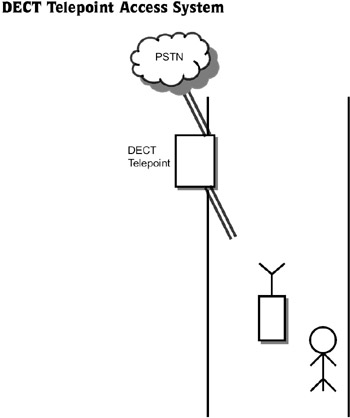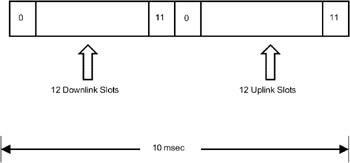12.5 CORDLESS TELEPHONY
|
| < Day Day Up > |
|
12.5 CORDLESS TELEPHONY
At home and the office, we use cordless telephones that provide limited mobility. ETSI developed a series of Cordless Telephony (CT) standards to provide cordless telephony services in residential and office areas. The first generation CT systems were analog systems, and hence the performance was poor. A second generation Cordless Telephony (CT-2) system can be used as a two-way cordless telephone in an office environment or as a two way cordless in the home. CT-2 is an FDMA-based system that operates in the 800MHz band. CT-3 is a digital version of CT-2 and uses TDMA-TDD as the access scheme. CT-3 operates in the 800–1000 MHz band with an overall data rate of 640kbps. The speech data rate is 32kbps. In CT-2 and CT-3, the range is 5 meters in built-up areas and 200 meters for line of sight. To enhance the capabilities of cordless telephone systems, ETSI developed the DECT standards.
Cordless telephone systems provide limited mobility and a short range. To provide cordless telephone services in residential and office environments, Cordless Telephony standards have been developed that have a maximum range of 200 meters.
12.5.1 Digital Enhanced Cordless Telecommunications (DECT)
European Telecommunications Standards Institute (ETSI) developed the DECT standard for cordless telephony. DECT-based handsets can be used in homes, at offices, or at public places such as shopping malls and airports.
The DECT standard developed by ETSI has three configurations: (a) for residential operation; (b) for access to telephone networks from public places; and (c) for use in office complexes.
In this configuration, in the home, an incoming telephone line can be shared by up to four extensions, as shown in Figure 12.7. There will be a DECT base station connected to the incoming telephone line that can communicate with any of the four extensions using radio. This configuration is a cordless PBX with four extensions.

Figure 12.7: DECT at home.
In the home configuration, a DECT system operates as a cordless PBX with one base station and up to four extensions.

Figure 12.8: Telepoint for public access.
In the telepoint configuration of DECT, a handset is connected to a telepoint base station, which in turn is connected to the public telephone network. When a handset is within the coverage area of the base station, outgoing calls can be made from the handset.
In places such as airports, railway stations, and large shopping complexes, a base station (called telepoint) can be installed. Using the DECT handset, the PSTN can be accessed through the telepoint. In such a case, it is expected that the user will not move considerably, so the handset should be within the coverage area of the base station. This service has the following disadvantages:
-
Only outgoing calls can be supported. If incoming calls are to be supported, a radio pager has to be integrated with the handset.
-
The environment in which the telepoint base stations are installed being noisy, special enclosures need to be provided (called telepoint booths).

Figure 12.9: DECT micro-cellular system.
In a microcellular system, the coverage area is divided into cells as in mobile networks; each cell size is typically about 10 meters in diameter. Because these systems operate inside buildings, the propagation conditions require such small cells. Such systems find application in office buildings and small industrial complexes. The cordless system using microcellular concept is also known as cordless PBX. Microcellular systems are also useful for installing in temporary locations such as construction sites, big exhibitions, etc. Unlike the telepoint system, microcellular systems do not provide public service, they serve only closed user groups. Each cell will have a base station. All the base stations will be connected to the switch (PBX). The PBX will have two databases: the home database (HDB) and the visitor database (VDB). These databases contain the information about the subscribers and their present locations. The DECT handset is connected to the base station using radio as the medium. When the handset moves from one cell to another, the radio connection automatically is transferred to the other base station.
In a DECT microcellular system, the service area is divided into small cells of about 10 meters diameter, and each cell has a base station. As a person moves from one cell to another cell while talking, the handset is connected to the nearest base station.
For all three configurations, the DECT standard specifies the frequency of operation, access mechanism, coding schemes, and such, which are described in the following sections.
DECT Standard
The broad specifications of DECT are as follows:
Range: The range of a DECT system is about 300 meters for a maximum peak power of 250 milliwatts. Average power is 10 milliwatts. However, in the home and telepoint configurations, the range can be about 10 to 50 meters so that the power consumption can be less. It is also possible to extend the range up to 5 kilometers by increasing the transmit power.
Frequency band: The DECT system operates in the frequency band 1880–1900 MHz. A total of 10 carriers can be assigned to different cells.
Voice coding: Voice is coded at 32kbps data rate using adaptive differential pulse code modulation (ADPCM).
Multiple access: The multiple access used is TDMA-TDD. The frame structure is shown in Figure 12.10. The frame duration is 10 milliseconds. The first 12 slots are for base to remote communication, and the next 12 slots are for remote to base communication. The same frequency is used for both base to remote and remote to base communication. The transmission data rate is 1152kbps. The channel assignment is dynamic: when a user has to make a call, the frequency and time slot will be allocated.

Figure 12.10: DECT TDMA-TDD frame structure.
Since there are 10 carriers, and each carrier will have 12 time slots, total number of voice channels supported is 120. If a telepoint base station is installed in a shopping complex, simultaneously 120 persons can make calls through the base station. In the home configuration, this is not required. However, the advantage of a DECT system is that the same handset used as a cordless telephone at home can be carried to the shopping complex or to the office to make calls.
A DECT system can be used as a wireless local loop using the telepoint configuration. In India, a number of villages are provided with telephone facilities using the DECT system developed at IIT, Madras. The only limitation of DECT is that mobility should not be more than 20 km/hour.
DECT operates in the 1880–1900 MHz band in TDMA/TDD mode. For voice communication, 32kbps ADPCM is used.
| Note | DECT can be used to provide wireless local loops for rural areas by increasing the radio transmit power. The handsets can be mobile, but with a restriction that the speed should not be more than 20 km/hour. |
|
| < Day Day Up > |
|
EAN: 2147483647
Pages: 313